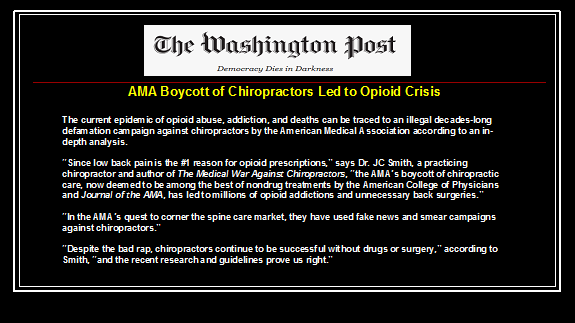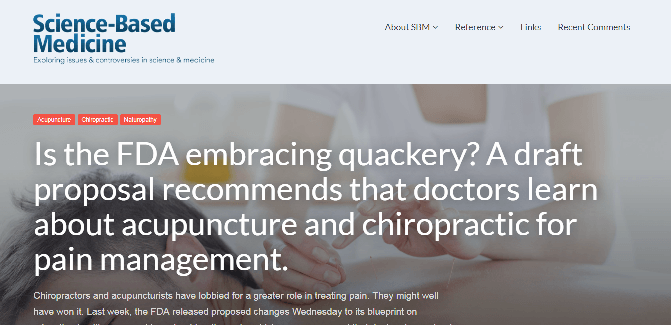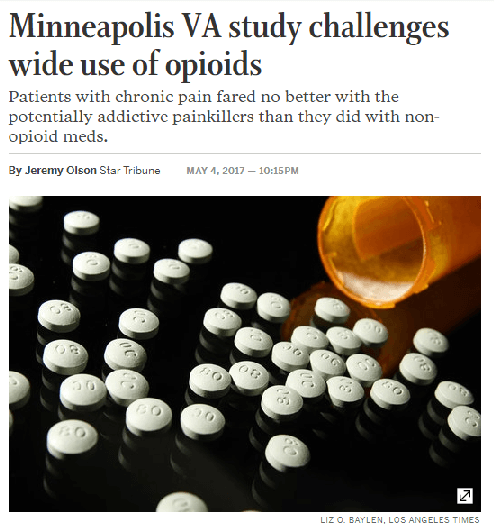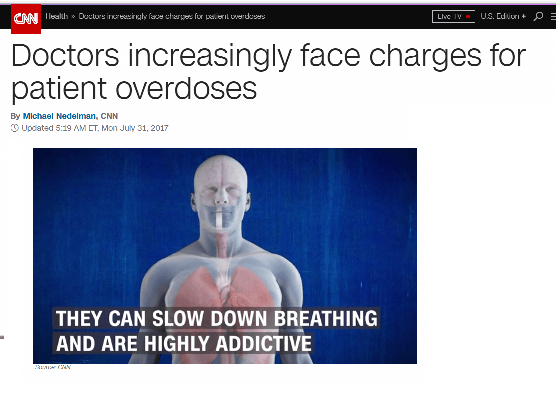Inconvenient Truth
As the opioid painkiller crisis worsens, so has the number of exposés about who is responsible for this medically-made crisis — the coalition of Big Pharma, promiscuous prescribers, pharmacists and the entire medical system hell-bent on a pill for every pain.
 America is still coming to grips with this prescription drug pandemic just as it is with global warming as former Vice President Al Gore found initially with criticism of his 2006 American documentary, An Inconvenient Truth.
America is still coming to grips with this prescription drug pandemic just as it is with global warming as former Vice President Al Gore found initially with criticism of his 2006 American documentary, An Inconvenient Truth.
Americans now face another inconvenient truth about being misled by their local PCPs about opioid painkillers, aka, medicinal heroin. But with thousands of deaths and addictions in every community, the truth is now being addressed albeit after the horses have left the barn.
The moral outrage among the public and press has finally approached the tipping point as new information comes forth about the deaths, addictions, and ineffectiveness of opioid painkillers and prescription drugs.
Although a terrible scourge for our nation, this is also a golden opportunity for the chiropractic profession that must use this drug disaster as proof of our value to the public with our brand of nondrug care. The allopathic approach to chronic pain was doomed from the start, and now the proof is positive with the new Pharmageddon.
Sadly, it took over 500,000 deaths via prescription drugs over the past decade to get the media’s attention with forecasts for another 650,000 in the upcoming decade unless something radically changes. The opioid crisis alone killed 33,000 in 2015 and could climb to nearly 94,000 in 2027.
More shocking facts: every 19 minutes, someone in the United States dies from an unintentional prescription drug overdose.[1]
Who doesn’t know someone who has become addicted to prescription drugs? Today one in 12 Americans can say they know someone who died from a prescription drug overdose.[2] No other disease can make that claim.
Analysts predict things will get worse — probably much worse — before they get better. Aside from the White House, numerous governmental agencies such as the CDC and NPS have investigated this medically-made pandemic offering superficial voluntary changes but avoiding the real problem—Big Pharma fueling promiscuous prescribers aided by pharmacists paid to push expensive narcotics.
If our police thought “El Chapo” ran a dastardly drug cartel, he was small fry compared to “Dr. Chapo” – the medical cartel ran by Big Pharma, backed by Congress, and media shills who all profit by this drug disaster.
This is an inconvenient truth the powers-to-be are finally addressing but with little success. Indeed, it’s nearly impossible to fight against the leading Capitol Hill lobby — the medical cartel — to convince congressmen and the public these wonder drugs are not so wonderful.
Disruptive Journalism
It’s time the chiropractic profession jump on this anti-opioid bandwagon by positioning our profession as the leading nondrug profession to combat chronic pain. In fact, a case can easily be made the boycott of chiropractors by the AMA has led to this pandemic of pain, addiction and deaths.
Despite the occasional backpack and scoliosis articles in the media, there is a strategy that may work better than WOM or print ads to reposition the public and press to our profession called disruptive journalism:
A disruptive company has one of two goals: design its product or service to match the demand of an emerging market or re-shape an existing product or service to meet the demand of customers unsatisfied by the current offering.
From this starting point, a marketing team designs an advertising campaign with disruptive messages that either challenge the conventional thinking in an existing market or speak to a new one.
If the chiropractic profession wants to disrupt the current national scandal in spine care (drugs, shots, surgery), we must “challenge the conventional thinking.”

This should be our first foray into disruptive journalism. Although the F4CP and ACA have issued press releases condemning the opioid crisis, they lack the “wow” factor to grab the public’s attention. If President Trump has taught Americans one thing, disruptive journalism and marketing is effective — his tweets were turned into billions of dollars of free advertising when the media picked them up.

We cannot continue to avoid the many controversies in spine care aside from opioids and pain pills. Our story is much bigger than merely a substitute for pain pills.
We must give to the public the entire backstory to this medical mess—our inconvenient truth about medical hate crimes to deter Americans from accessing the best nondrug care for their chronic pain and health issues in general. People simply do not know the value of the spine to their overall health.
This is a new disruptive revelation since the press has rarely, if ever, offered a positive, in-depth, “fair and balanced” article about the benefits chiropractors bring to an ailing society where back pain is the leading disability in our nation. To be sure, as the third-largest physician-level health profession in the world, we remain missing in the media. Whether fake news or media disinformation, we see examples of hate criminals at the medical troll blog, Science-Based Medicine, a store front for chirophobes to bash CAM professions.

Indeed, the moral outrage against opioids should include outrage against the medical boycott of chiropractic care over the past century, thus depriving the public of the best nondrug treatment for chronic pain. The public needs to know the AMA has its hands deep in Big Pharma’s pockets and has little desire to dismantle its medical monopoly.
Without question, the AMA has blood on both hands.
New Sheriff
It’s time to take the smoking gun out of the hands of these medical cowboys.
As Dr. Don Teater from the National Safety Council said, “Opioids do not kill pain. They kill people.”
Mark Schoene, the 25-year editor of The BackLetter, an international spine research journal, makes the case primary care medical practitioners are actually dangerous to patients:
“One can make the argument that the most perilous setting for the treatment of low back pain in the United States is currently the offices of primary care medical practitioners—primary care MDs. This is simply because of the high rates of opioid prescription in these settings.”[3]
Since the medical professionals cannot contain themselves, state attorney generals and local governments have intervened to stop this Pharmageddon by suing promiscuous physicians, pharmacists and Big Pharma.
Listed below is a timeline of recent press releases and lawsuits aimed to stop this Pharmageddon since the federal government and medical societies have been impotent to stop this medical mess other than giving lip service as we’ve witnessed with the President’s Commission on Combating Drug Addiction and the Opioid Crisis, stating that its “first and most urgent recommendation” is for the president to “declare a national emergency under either the Public Health Service Act or the Stafford Act.”
Yada, yada, yada — the same political sentiments we’ve heard for years now from the CDC, NPS, NIH, ,and other investigations. This Johnny-come-lately report noted “With approximately 142 Americans dying every day. America is enduring a death toll equal to September 11th every three weeks.”
The commission, led by New Jersey Gov. Chris Christie, states that the goals of such a declaration would be to “force Congress to focus on funding” and to “awaken every American to this simple fact: if this scourge has not found you or your family yet, without bold action by everyone, it soon will.”
Gentlemen of the Jury
Aside from the usual governmental lip-service to throw more money at this problem, such as making available opioid antagonist meds, other news reports have taken a more hard-line approach via the courts:
- On July 31, 2017, an article by Michael Nedelman at CNN.com, “Doctors increasingly face charges for patient overdoses,” highlighted the increasing scrutiny of the opioid crisis caused by promiscuous prescribers.
Mr. Nedelman writes many advocates want to focus on the doctor’s office in order to protect patients at risk:
“If we’re ever going to bring (the opioid epidemic) to an end … we need these folks to prescribe much more cautiously,” Dr. Andrew Kolodny said. “If you can get your patients off of opiates that should be the goal.”
Not only getting patients off of opiates, but getting them off all pain pills should be the goal of every physician as the new American College of Physicians (ACP) guideline suggests, including OTC drugs. Even the new 2017 ACP guidelines omitted OTC drugs that were previously listed in its 2007 guidelines as a front line treatment.
New research shows there is no safe or effective pain pill for chronic pain—all have serious and even deadly side effects.
On May 4, 2017, a VA study was released, “Strategies for Prescribing Analgesics Comparative Effectiveness (SPACE).” According to researchers, it was the first randomized trial to evaluate the effectiveness of long-term opioid therapy. Erin E. Krebs, MD, MPH, and colleagues from the Minneapolis Veterans Health Care System, found “Opioids are perceived as strong pain relievers, but our data showed no benefits of opioid therapy over non-opioid medication therapy for pain.”
Her study found opioids provided no better pain relief for patients with low back pain or painful osteoarthritis than safer analgesics such as nonsteroidal anti-inflammatory drugs, acetaminophen, and other nonopioid pain medications.

Dr. Krebs stated, “We already knew that opioids carry more risks of serious harms for patients…The data do not support opioids’ reputation as ‘powerful painkillers.’ The results support CDC [Centers for Disease Control and Prevention] guideline recommendation that non-opioid medications are preferred for chronic pain.”
“If pain doctors still think these opioid medicines are effective, then they have a lot of explaining to do and their competence and professionalism deserve to be challenged,” added Chris Johnson, MD. Too bad he failed to mention chiropractors offer the best nondrug treatment for chronic pain.
- On June 30, 2017, another shot across the bow of Big Pharma indicted its drug dispensers, “Pharmacists May Be Legally Liable for Opioid Overdoses.” As agents of Big Pharma, these middlemen have profited handsomely allthewhile knowing perfectly well the damage they are rendering without warning gullible patients about the addiction of opioids.
- On August 1, 2017, the Annals of Internal Medicine also delivered another shock to the medical profession, “Prescription Opioid Use, Misuse, and Use Disorders in U.S. Adults: 2015 National Survey on Drug Use and Health.”
- On August 2, 2017, National Public Radio jumped on this anti-opioid bandwagon with “Should the Opioid Crisis Be Declared a National Emergency?” In an interview with Dr. Andrew Kolodny, an addiction specialist with Brandeis University, he states:
“This is a public health emergency,” noting that since 1999, more than 300,000 Americans have died from opioid overdoses. Drug overdoses now kill more people each year than gun homicides and car crashes combined.
“There should be naloxone available in the Starbucks, because we have people overdosing in the bathrooms of Starbucks,” he says. “Any place where people could be overdosing, naloxone should be available.”
The elephant missing in the effort to get patients off of opiates is expanding the role of nondrug alternative and complementary treatments (CAM) that have recently been cited by the ACP and JAMA as the front-line treatments for chronic low back pain, the leading reason for prescription painkillers.[4]
The Joint Commission’s policy revision in 2014 to include chiropractic care and the National Pain Strategy study in 2016 on opioid abuse certainly helped to open the same door that the medical establishment kept closed to DCs for decades.
Ironically, the Joint Commission was the thug behind the AMA’s boycott of chiropractic by enforcing the illegal medical ethics of the Committee on Quackery with the loss of licensure if a hospital or MD worked with chiropractors. Indeed, the times are changing.
- On March 10, 2017, “Opioid Overload” revealed the enormity facing rural towns in this opioid crisis:
A county in West Virginia is suing 10 wholesale drug distributors — including subsidiaries of Walmart, Walgreens, Rite Aid, and CVS — alleging the companies flooded the state with prescription painkillers, contributing to an epidemic of opioid addiction and overdoses.
Cabell County, which includes the West Virginia city of Huntington, near the state’s western border with Ohio, has a population of about 96,000, but the lawsuit alleges the drug distributors sold local retailers nearly 40 million doses of prescription opioids from 2007 to 2012.
[This equates to 416 pills per person]
“The epidemic still rages because the fines and suspensions imposed by the DEA do not change the conduct of the wholesale distributor industry,” the lawsuit alleges. “They pay fines as a cost of doing business in an industry which generates billions of dollars in annual revenue.”
- On May 31, 2017, the state of Ohio has sued five major drug manufacturers for their role in the opioid epidemic. In the lawsuit, state Attorney General Mike DeWine alleges the five companies “helped unleash a health care crisis that has had far-reaching financial, social, and deadly consequences in the State of Ohio.” Named in the suit are Purdue Pharma, Endo Health Solutions, Teva Pharmaceutical Industries and subsidiary Cephalon, Johnson & Johnson and subsidiary Janssen Pharmaceuticals, and Allergan.
- On June 8, 2017, Nassau County on Long Island announced it will file a lawsuit in New York State Court against 19 pharmaceutical companies and five local doctors, alleging the companies and the physicians knew about the addictiveness of prescription painkillers and didn’t properly inform patients.
- On June 9, 2017, Ulster has become latest county in New York state, and the fourth in the Mid-Hudson/Catskills region, to announce it will sue major pharmaceutical companies over the opioid crisis.
- On June 15, 2017, Attorney General George Jepsen announced Connecticut is working with a bipartisan coalition of attorneys general from across the country on an ongoing investigation to evaluate whether pharmaceutical manufacturers have engaged in unlawful practices in the marketing and sale of prescription opioids.
- On Jun 21, 2017, Missouri Attorney General Josh Hawley filed suit against three large pharmaceutical companies, saying their “campaign of fraud and deception” led to a startling opioid crisis in the state. Hawley said the three companies over several years misrepresented the addictive risks of opioids, often using fraudulent science to back their claims. As a result, thousands of Missourians dealing with chronic pain were given unnecessary opioid prescriptions.
- On June 23, 2017, the city, county and a local fire district in Stockton, California, sued several major pharmaceutical companies and a medical distribution firm, charging them with damaging the local economy by promoting the use of opioid painkillers they knew to be dangerous and extremely addictive.
- On June 28, 2017, Kentucky state officials will pursue multiple lawsuits against the manufacturers and distributors of prescription pain medications in the wake of the state’s opioid crisis. Attorney General Andy Beshear said the drug manufacturers of prescription pain pills illegally marketed opioids to doctors and patients.
- On June 30, 2017, Oklahoma Attorney General Mike Hunter on Friday sued more than a dozen manufacturers of opioid pain medication, alleging that deceptive marketing campaigns by the drug makers have fueled the state’s opioid epidemic.
- On July 10, 2017, Palm Beach County is considering joining a growing number of states, cities and counties that have filed lawsuits accusing drug companies of misleading patients and doctors about the dangers of prescription pain medication.
A string of articles have appeared about the danger of NSAIDs and other OTC pain pills that purportedly were safe and effective. Despite recommended over opioids for long-term pain, studies found NSAIDs are not without serious risks, too.
· On December 24, 2016, a Danish study by Kathrine B. Sondergaard, et al, “Non-steroidal anti-inflammatory drug use is associated with increased risk of out-of-hospital cardiac arrest: a nationwide case–time–control study” also found that short-term treatment with non-selective NSAIDs, particularly ibuprofen and diclofenac, was associated with an increased early risk of cardiac arrest. NSAIDs may cause intolerable levels of nausea or gastrointestinal pain, and can be contraindicated in some patients because of kidney disease or bleeding disorders.
- On January 20, 2017, a similar study Down Under by Machado GC, Maher CG, et al. from the University of Sydney, “Non-steroidal anti-inflammatory drugs for spinal pain: a systematic review and meta-analysis,” admitted paracetamol is ineffective for spinal pain, but also found no consensus on the efficacy of non-steroidal anti-inflammatory drugs (NSAIDs) for chronic pain.
- On February 2, 2017, the George Institute for Global Health also published “The drugs don’t work, say back pain researchers”, a review of the Machado study:
· On May 9, 2017, the BMJ published a similar study, “Risk of acute myocardial infarction with NSAIDs in real world use: bayesian meta-analysis of individual patient data,” by Michèle Bally et al from the University of Montreal.
· On May 10, 2017, this article went viral in the media, “NSAIDs Raise Risk of Heart Attack Within Days” that mentioned the consumption of any kind of non-steroidal anti-inflammatory drugs (NSAIDs) such as ibuprofen could increase the risk of heart attack by 31 percent:
“Taking prescription strength non-steroidal anti-inflammatory drugs (NSAIDs) raises the risk of a heart attack as soon as the first week of use, according to a large new study published in The BMJ.”
Conclusion:
“All NSAIDs, including naproxen, were found to be associated with an increased risk of acute myocardial infarction. Risk of myocardial infarction with celecoxib was comparable to that of traditional NSAIDS and was lower than for rofecoxib. Risk was greatest during the first month of NSAID use and with higher doses.”
· According to the FDA, as many as 20,000 people die from NSAID use every year, similar to the deaths from the over-use of antibiotics that created the pandemic of super-bug infections.
These studies beg the question perhaps only a chiropractor might ask: how many of these heart attacks are possibly due to people taking NSAIDs for their back attacks?

The bottom line is obvious: whether NSAIDs, opioid painkillers, or opioid antagonist drugs, these drug treatments are often unnecessary and ineffective, plus they have serious side effects.
In fact, there is no safe drug.
Chiropractors to the Rescue
The recent ACP and JAMA guidelines are more proof chiropractic care is the leading nondrug treatment for the leading cause of opioid use — low back pain and musculoskeletal disorders in general.
We had the same excitement and proof in 1994 when the AHCPR Guideline #14 on acute low back pain in adults report was released, only to be disappointed when the medical news reporters in the media twisted the findings and Rep. Newt Gingrich (R-GA), leading the charge with orthopedists on Capitol Hill to de-fund the agency, took it out of the guideline business.
I wrote about this political sabotage in Spine Surgeons Wrath, which I fear continues today with the appointment of orthopedist Dr. Tom Price as the new secretary of HHS who resists reform and supports fee-for-service. I doubt there will be a sudden paradigm shift among government programs away from drugs, shots, and surgery to nondrug, nonsurgical providers as the new guidelines suggest.
The ACP and JAMA guidelines suggest drugs should be used only after nondrug, nonsurgical care fail beforehand, yet this fact is generally omitted in the media’s discussion.
Like a bolt of lightning, the good news immediately disappeared in the media the next day.
Research supporting CAM was reaffirmed with the new guidelines as this timeline shows:
- On February 14, 2017, spinal manipulative therapy (SMT) was listed as a front-line treatment by the updated American College of Physicians (ACP) guidelines that recommended no drugs, not even OTC, epidural shots or surgery. ACP recommended hands-on care such as SMT, massage therapy, yoga, tai chi and other CAM treatments.
- On April 11, 2017, another shocking study was released in JAMA, “Association of Spinal Manipulative Therapy With Clinical Benefit and Harm for Acute Low Back Pain Systematic Review and Meta-analysis” that recommends spinal manipulation as a first-line treatment for LBP.
- In the same edition, Richard Deyo, MD, MPH, authored a somewhat skewed editorial, “The Role of Spinal Manipulation in the Treatment of Low Back Pain,” published in conjunction with the original investigation. (You might enjoy my response to his editorial, “Bones of Contention”)
- Also on April 11, NPR aired a recap: “Spinal Manipulation Can Alleviate Back Pain, Study Concludes.”
- A few weeks later on May 1, 2017, Aaron E. Carroll, MD, wrote in the New York Times an insightful analysis, “For Bad Backs, It May Be Time to Rethink Biases About Chiropractors.” (You will enjoy my response to him)
Finally, one forthright MD, Dr. Carroll, was willing publicly to admit his bias about chiropractic care!
“A physician like me might suggest any number of potential treatments and therapies. But one I never considered was a referral for spinal manipulation. It appears I may have been mistaken. For initial treatment of lower back pain, it may be time for me (and other physicians) to rethink our biases.”
Consumer Reports published two positive articles soon after the ACP and JAMA guidelines were released:
- Stop Back Pain Without Drugs by Sally Wadyka, Consumer Reports, February 14, 2017.
For the first time, the American College of Physicians is advising treating back pain with nondrug measures like tai chi, yoga, chiropractic, and massage before resorting to over-the-counter or prescription pain relievers.
- Spinal Manipulation Can Ease Your Aching Back by Teresa Carr, Consumer Reports, April 11, 2017.
A new analysis finds that the hands-on technique works as well as pain drugs and is safer, too.
When you wrench your back, your first impulse may be to rummage through the medicine cabinet for an over-the-counter pain drug or even ask your doctor to prescribe a strong opioid painkiller such as Percocet or Vicodin. But an analysis published April 11 in the Journal of the American Medical Association finds that spinal manipulation can ease your backache and get you moving again without the risk of medication side effects.
Tear Down This Wall
It’s one thing to have supportive research and best-practices guidelines, but it’s another thing for patients to have equal access to chiropractic care as they do to medical care.
On February 19, 2016, Dr. Erin Krebs spoke at the American Academy of Pain Medicine’s annual meeting and made a few remarkable comments on the theme of “ensuring access to pain care”:
“We also need to put opioids in their place. Opioids are only one treatment for pain and probably not the best treatment for most people with chronic pain. If we can ensure all patients with chronic pain are getting optimal non-opioid pain care, our use of opioids will be more targeted and more effective.”[5]
Due to the illegal boycott of chiropractors, a major problem with CAM treatments is coverage as Dr. Krebs admits:
“Lack of access to other pain treatments is part of the reason for opioid over-prescribing. We have evidence-based treatments for pain — mostly low tech, high touch treatments — that most people with chronic pain can’t access.”[6]
Whether due to chirophobia among MDs or institutional bias among insurance carriers guided by a “perverse” motivation to increase costs and thereby increase profits, the net result is poor outcomes and high costs.
The typical medical protocol of “pain management clinics” by an “interventional pain specialist” preceding spine surgery is the same medical care that has been deemed “low-value” spine care and branded by editor Schoene as “the poster child for inefficient spine care.”[7]
To disrupt the present medical mess, we need to educate the public and press on additional important points, such as:
- Inept MDs on MSDs
- Debunked Bad Disc Theory
- Failed Back Surgeries
- Call for Moratorium on Back Surgery
- Ineffective Epidural Steroid Injections
- Ineffective Physical Therapy for LBP
We cannot remain mute on the damning evidence against medical spine care and hope to be heard.
Being polite is not disruptive; indeed, we need to Act Up!
After the release of the ACP and JAMA guidelines, why didn’t we see any articles in the mainstream media touting, “Chiropractors Were Right All Along” or “Chiropractic Care Best for Back Pain” or “Chiropractors Vindicated”?
Perhaps the most attention grabbing article should be “Opioid Crisis Due to Medical Boycott of Chiropractors.” Indeed, if the century-long illegal boycott of chiropractors had never occurred and if chiropractors had assumed their rightful place as the primary spine care providers, this drug tragedy would not have attained the same catastrophic level.
Here are a few past articles I’ve written touting our brand:
- Chiropractors Blame AMA
- Chiropractors Cry Foul
- Chiropractors Call for Reform
- Chiropractors Have Your Back
- The Chiropractor as Hero
If not lengthy articles, why haven’t we created disruptive and challenging ads to confront the medical misinformation about spine care and chiro care? We need to move past articles on back packs and proper lifting habits or the use of sports celebrities.
Indeed, most people are unaware of these monumental new studies. Nor did any of these articles give credit where credit is due to chiropractors who have fought the good fight in this 100 year battle to keep SMT alive against the medical onslaught of drugs, shots, and surgery. If it weren’t for brave DCs, this healing art would be dead today.
It’s past time to disrupt the world with our story even if it’s an inconvenient truth.
[1] American Public Health Association, “Prevention and Intervention Strategies to Decrease Misuse of Prescription Pain Medication”
[2] Dylan Scott, “1 in 3 Americans blame doctors for national opioid epidemic, ATAT-Harvard poll finds.” Boston Globe, March 17, 2016
[3] the BackLetter, volume 30, number 10, 2015
[4] Denise Boudreau, PhD, Michael Von Korff, ScD, Carolyn M. Rutter, PhD, Kathleen Saunders, G. Thomas Ray, Mark D. Sullivan, MD, PhD, Cynthia Campbell, PhD, Joseph O. Merrill, MD, MPH, Michael J. Silverberg, PhD, MPH, Caleb Banta-Green, and Constance Weisner, DrPH, MSW. “Trends in De-facto Long-term Opioid Therapy for Chronic Non-Cancer Pain,” Pharmacoepidemiol Drug Saf. 2009 December; 18(12): 1166–1175. doi:10.1002/pds.1833.
[5] “What the CDC’s Opioid Prescribing Guidelines Mean for Primary Care Physicians,” Clinical Pain Advisor, February 19, 2016
[6] “What the CDC’s Opioid Prescribing Guidelines Mean for Primary Care Physicians,” Clinical Pain Advisor, February 19, 2016
[7] The BACKPage editorial vol. 27, No. 11, November 2012.